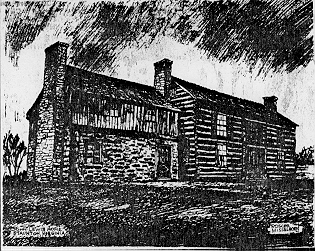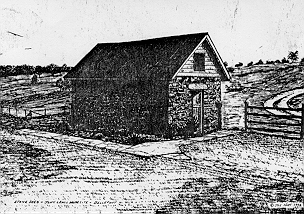John Lewis Homesite
The John Lewis homesite, on the farm known as Belle-fonte (also Bellefont and other variations) is located off Va. 254 (New Hope Road) just less than a mile east of Statler Boulevard, along Lewis Creek. Tradition has it that John Lewis was descended from French Huguenot (or, alternatively, Welsh or English) stock on his paternal side and Ulster Scotch on his maternal side. He was born in Donegal County, Ireland, in 1678. The reason he left Ireland is engraved on his tombstone: He "slew the Irish Lord." Family tradition, passed on in slightly variant versions, indicate that his landlord, variously identified as Sir Mungo (or Mingo) Campbell or as Lord Clonmithgairn, unjustly and illegally attempted to raise the rents on the leaseholders on his lands, on the premise that the lands would be forfeited if the higher rents were not paid. Soon after Lewis stated his refusal to pay the increased rents, Sir Mungo and his retainers, identified as a profligate lot, attempted to eject him by force. A musket fired into Lewis' barricaded home killed his ailing brother, Charles Lewis, and wounded his wife, Margaret Lynn Lewis, in the hand. An enraged Lewis charged from the house and promptly split Sir Mungo's skull with a shelelah, his only weapon. Lewis also killed the landlord's steward and, with the help of some domestic servants, drove away the remaining retainers. While in the right, and later exonerated for his unfortunate actions, Lewis felt compelled to flee Ireland to avoid the wrath of Sir Mungo's family and friends. Tradition, again, relates that he sailed for Portugal, then Philadelphia, arriving at the latter port around the year 1728. Within two years, his family from Ireland joined him and either before or after this reunion (sources vary), Lewis moved to Lancaster, Pa. There he spent another year or so with his family, including wife Margaret, four sons (possibly three), and two daughters, before they headed south into Virginia's Shenandoah Valley. Written documentation is again scant, but it is generally believed that the Lewis family and a group of other settlers reached the headwaters area of the South Fork of the Shenandoah River during the summer of 1732. Some historians have argued with some plausibility that other settlers had filtered into the area that presently comprises Augusta County prior to the arrival of the John Lewis party. But, if not the first, John Lewis is generally recognized as the acknowledged leader of the largest group of "pioneers" to settle in the upper Valley. The first Lewis homestead was located on Middle River, but the family soon moved to the property known as Bellefonte (for "fine" or "good spring"). While available space precludes a full recounting of the story of John Lewis and his remarkable family, we can here itemize in rough chronological order some of the events that occurred in the area during his lifetime, events in which he was a prominent participant. The last 30 years of his life, from 1732 until he died at age 84 in 1762, were spent here in the upper Valley. - In 1732 the area was part of Spottsylvania County, then Orange County after 1734. - In 1736, William Beverley received a grant of more than 118,000 acres from King George II of England. William Gooch was governor of Virginia at that time. Lewis, who had been technically a squatter on the land for four years, acquired official title to his lands in 1739. His land comprised 2071 acres at that time, the largest tract in Beverley Manor. The cost was 14 pounds, which was forgiven by Beverley because Lewis served as leader and guide to hundreds of incoming settlers, which often strained his hospitality. - By 1737, perhaps before and certainly after, John Lewis and one or more of his sons, often with other partners, were acquiring grants for large tracts of land outside Beverley Manor boundaries, including the Pastures areas to the west. In 1749 a group including John Lewis acquired lands along the Greenbrier River. - In 1738 Augusta County was established by the Virginia General Assembly, but the county was not incorporated, with sufficient population to sustain county courts, until 1745. - In 1738 or 1739, Lewis hosted the first minister, who delivered the first sermon in the upper Valley in the person of the Reverend James Anderson, Presbyterian minister from the Synod of Philadelphia. Lewis, with others, also secured the services of the first settled, resident minister of the upper Valley, Rev. John Craig, in 1840. - Perhaps as early as 1739, although this is problematic, John Lewis was engaged in the milling trade. The original name of Lewis Creek was Lewis' Mill Creek. - When the county was incorporated in 1745, Lewis was appointed as one of the original justices of the peace. He served in this capacity, and as a member of the Augusta County Court, until at least 1752. - Staunton, originally called Beverley's Mill Place, received its name in 1748, after Lady Staunton, wife of Governor Gooch. Lewis' leadership in attracting new settlers, and his great sense of civic responsibility, witnessed in his advocacy of schools, new roads, and other community projects, proved of great value. We hope to provide further information on John Lewis and his prominent family members in future Sketches. Now we turn to the history of the homesite. According to Augusta County deed records, the site of the original Bellefonte (Lewis) homestead was owned successively by William Beverley, John Lewis, then his son, Andrew Lewis. The Lewis family held the land until 1793, when it was deeded to Robert McCulloch. The "stone house" on the property is mentioned in this transaction. McCulloch died c. 1806, and the property was acquired from his estate by D. W. Patterson in 1817. In 1837 and 1842, Patterson added improvements and new buildings on the land, according to tax records. John A. Harmon, of Civil War fame as Stonewall Jackson's quartermaster, a bluff and earthy man, bought the property from the Patterson estate and it remained in his possession through the war years. In 1914, Henry Harrison (known as "Harry") Hevener purchased the homesite. When he died in 1948, title passed to his daughter Mrs. R. W. Hudlow. She deeded the home and surrounding property to her grandchildren, Karen Pendergrass and Park Thompson in 1981. Park and his wife Sandy bought out his sister's interest that year and remain owners of the home and about 150 acres today. Two drawings accompany this sketch. The first is a charcoal rendering drawn
by Roscoe Misselhorn, probably from a photograph taken in the early 1930's. Park
Thompson provided us with this drawing. The second is of a stone shed about 12-by-18 feet, once probably a smokehouse
and today used for storage, that was built in 1935 from the stones removed from
the portion of the homestead pictured to the left in the other sketch. This shed
is located about 30 feet off the northwest corner of the house, in the present
real left corner of the yard. Many questions remain about the origin and age of these buildings. Many printed sources over the years claim that the stone portion (one story) was the original John Lewis fort-home, built as early as 1732, or sometime between then and 1740. A thorough architectural-historical analysis of the house, using
dehydrochronology (dating by tree growth rings) and, perhaps, refined carbon
dating, and at least sample scientific digs would be welcome. Such an in-depth
analysis of the home and site could reveal to us more clearly how much of the
material Lewis legacy remains there.
|

